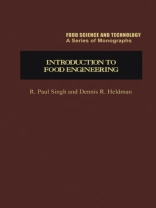Introduction to Food Engineering deals with the engineering concepts in food processing employing a unit operations approach. The book focuses on mass and energy balances, fluid flow, energy utilization, refrigeration, heat transfer, food freezing, evaporation, dehydration, and psychometrics. It is in line with primary topics recommended by the Institute of Food Technologists of the U.S.A. The text reviews some concepts related to food science such as the equation of state and perfect gas law, laws of thermodynamics, and conservation of mass. The book also discusses the transport of liquid foods and the three types of utilities used in food processing: 1) steam generation and utilization; 2) natural gas utilization; and 3) electric power utilization. The text explains how to determine the properties of food and the different approaches that can be used to obtain the food’s thermal properties prior to using the proper heat-exchange equipment. Food preservation also involves freezing (direct or indirect contact systems), evaporation, dehydration, and psychometrics (involving thermodynamic properties of gas-vapor mixtures). The book is suitable for nutritionists, food technologists, advanced under-graduate and beginning graduate students in food science and technology, and professionals whose works are in the food processing, research, and preservation industry.
Paul Singh
Introduction to Food Engineering [PDF ebook]
Introduction to Food Engineering [PDF ebook]
购买此电子书可免费获赠一本!
语言 英语 ● 格式 PDF ● ISBN 9780323138123 ● 出版者 Elsevier Science ● 发布时间 2012 ● 下载 6 时 ● 货币 EUR ● ID 2637640 ● 复制保护 Adobe DRM
需要具备DRM功能的电子书阅读器












